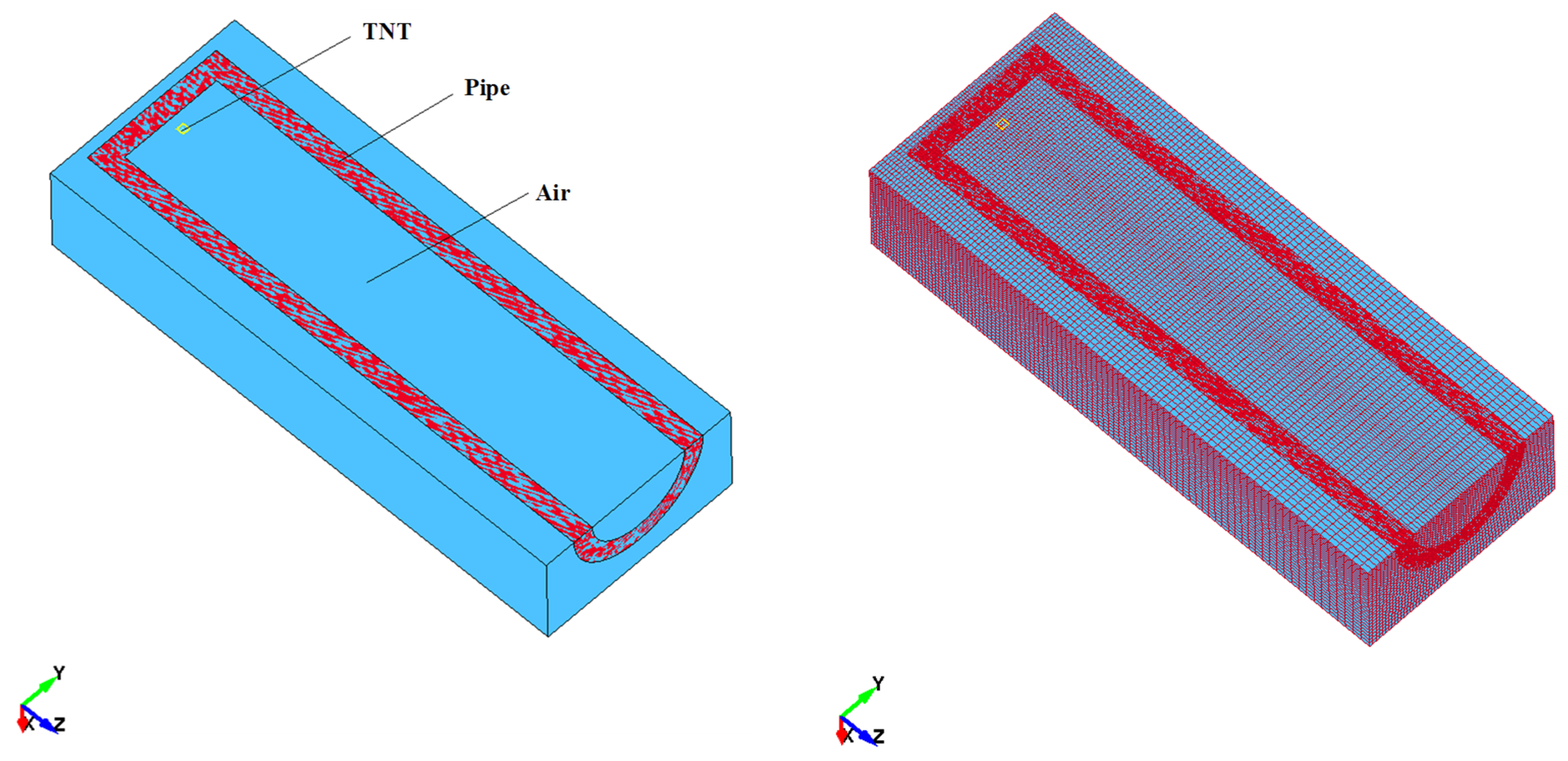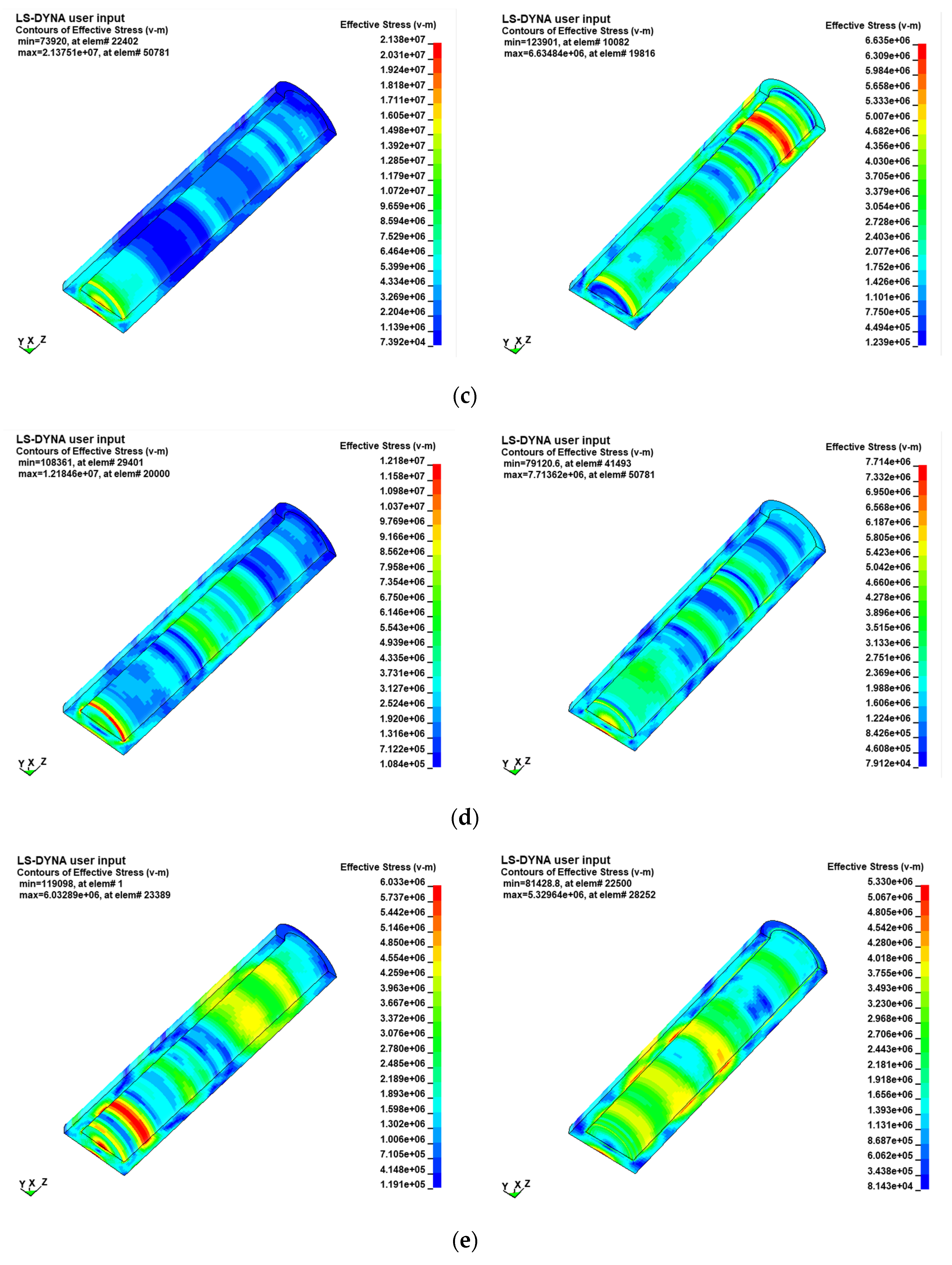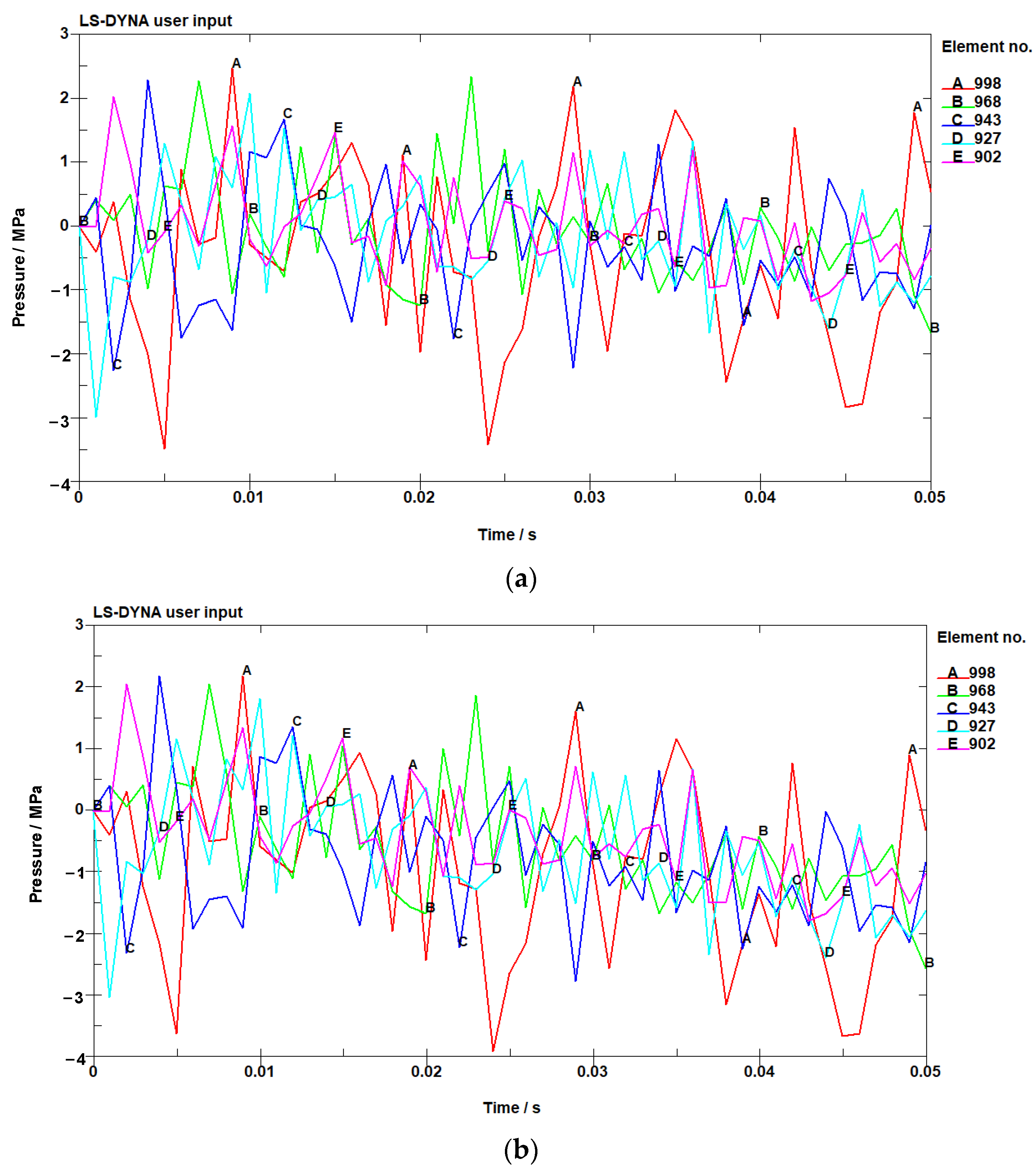Numerical Study on Influence of Wall Thermal Effect on Thermal Impact of Gas Explosion
Abstract
:1. Introduction
2. Numerical Simulation
2.1. Basic Control Equations
- (1)
- Momentum equationwhere, is Cauchy, is volume force per unit mass, and is accelerated velocity.
- (2)
- Mass conservation equationwhere, is current mass density, is initial mass density, = is relative volume, and = is a deformation gradient.
- (3)
- Energy equationwhere, is current configuration volume, is a strain rate tensor, and is bulk viscous resistance. The representation of deviatoric stress and pressure is as follows:
2.2. Physical Model
3. Analysis and Discussion of Simulation Results
3.1. Equivalent Stress Distribution of Pipe under Thermal Impact Effect of Gas Explosion
3.2. Wall Response of Measuring Points under Different Thermal Conductivity Coefficients
3.2.1. Pressure and Analysis on Pipe Wall at Measuring Points
3.2.2. Displacement and Analysis of Measuring Points on Pipe Wall
3.2.3. Time History Curve of Shock Wave Velocity at Measuring Points in the Air Region
4. Conclusions
- (1)
- When the pipe wall is approximately insulated, the phenomenon of stress concentration is more obvious, and the equivalent stress distribution is relatively uneven. The degree of thermal dissipation from the pipe wall affects the gas explosion intensity. A portion of the energy generated by gas explosions is dissipated through the thermal dissipation of the pipe wall, resulting in greater gas explosion intensity under the pipe wall conditions of the approximate insulation.
- (2)
- With an increase in the thermal conductivity of the pipe wall, the peak pressure at each measuring point of the pipe decreases as a whole. Under the condition of a thermal conductivity coefficient of 60 W/(m·K), the peak pressure at the measuring point of the pipe wall is the smallest compared to other conditions.
- (3)
- As the thermal conductivity of the pipe wall increases, the degree of thermal dissipation on the pipe wall becomes stronger, and the amount of thermal dissipation through the pipe wall increases, resulting in a decrease in the energy that subsequently drives the shock wave and a decrease in the impact degree of the pipe wall.
- (4)
- With an increase in the thermal conductivity of the pipe wall, the radial displacement values of the arranged measuring points decrease, and the gas explosion energy involved in expansion and work in pipes with high thermal conductivity is lower, which reduces the intensity of the explosion wave. After the gas explosion, the amount of thermal dissipation through the pipe wall is greater at a location farther away from the explosion source, resulting in an increase in the velocity difference of the shock wave due to an increase in the thermal conductivity of the pipe wall.
Author Contributions
Funding
Institutional Review Board Statement
Informed Consent Statement
Data Availability Statement
Conflicts of Interest
References
- Ye, Q.; Wang, G.G.; Jia, Z.; Zheng, C. Experimental study on the influence of wall heat effect on gas explosion and its propagation. Appl. Therm. Eng. 2017, 118, 392–397. [Google Scholar] [CrossRef]
- Baiquan, L.; Congguang, J. Energy changing characteristics of explosion wave and heating effect of wall. J. China Coal Soc. 2004, 29, 429–433. [Google Scholar]
- Kang, X.; Veeraragavan, A. Experimental investigation of flame stability limits of a mesoscale combustor with thermally orthotropic walls. Appl. Therm. Eng. 2015, 85, 234–242. [Google Scholar] [CrossRef]
- Ezekoye, O.; Greif, R.; Sawyer, R. Increased surface temperature effects on wall heat transfer during unsteady flame quenching. Symp. (Int.) Combust. 1992, 24, 1465–1472. [Google Scholar] [CrossRef]
- Jiang, B.; Lin, B.; Zhu, C.; Zhai, C.; Liu, Q. Premixed methane-air deflagrations in a completely adiabatic pipe and the effect of the condition of the pipe wall. J. Loss Prev. Process. Ind. 2013, 26, 782–791. [Google Scholar] [CrossRef]
- Yan, Y.; Wang, H.; Pan, W.; Zhang, L.; Li, L.; Yang, Z.; Lin, C. Numerical study of effect of wall parameters on catalytic combustion characteristics of CH4/air in a heat recirculation micro-combustor. Energy Convers. Manag. 2016, 118, 474–484. [Google Scholar] [CrossRef]
- Lee, M.J.; Cho, S.M.; Choi, B.I.; Kim, N.I. Scale and material effects on flame characteristics in small heat recirculation combustors of a counter-current channel type. Appl. Therm. Eng. 2010, 30, 2227–2235. [Google Scholar] [CrossRef]
- Norton, D.; Vlachos, D. Combustion characteristics and flame stability at the microscale: A CFD study of premixed methane/air mixtures. Chem. Eng. Sci. 2003, 58, 4871–4882. [Google Scholar] [CrossRef]
- Wang, L.-Q.; Ma, H.-H.; Shen, Z.-W. An experimental investigation on explosion behaviors of syngas-air mixtures in a vessel with a large blockage ratio perforated plate. Fuel 2019, 264, 116842. [Google Scholar] [CrossRef]
- Sun, Z.-Y.; Li, G.-X. Turbulence influence on explosion characteristics of stoichiometric and rich hydrogen/air mixtures in a spherical closed vessel. Energy Convers. Manag. 2017, 149, 526–535. [Google Scholar] [CrossRef]
- Huang, K.; Sun, Z.; Tian, Y.-C.; Wang, K.-L. Turbulent combustion evolution of stoichiometric H2/CH4/air mixtures within a spherical space. Int. J. Hydrogen Energy 2020, 45, 10613–10622. [Google Scholar] [CrossRef]
- Wan, J.; Fan, A.; Yao, H.; Liu, W. Effect of thermal conductivity of solid wall on combustion efficiency of a micro-combustor with cavities. Energy Convers. Manag. 2015, 96, 605–612. [Google Scholar] [CrossRef]
- Jiang, L.; Zhao, D.; Guo, C.; Wang, X. Experimental study of a plat-flame micro combustor burning DME for thermoelectric power generation. Energy Convers. Manag. 2011, 52, 596–602. [Google Scholar] [CrossRef]
- Zhang, B.; Chang, X.; Bai, C. End-wall ignition of methane-air mixtures under the effects of CO2/Ar/N2 fluidic jets. Fuel 2020, 270, 117485. [Google Scholar] [CrossRef]
- Campbell, A.N. The effect of external heat transfer on thermal explosion in a spherical vessel with natural convection. Phys. Chem. Chem. Phys. 2015, 17, 16894–16906. [Google Scholar] [CrossRef] [PubMed]
- Jianlong, W.; Aiwu, F.; Yi, L.; Hong, Y.; Wei, L.; Xiaolong, G.; Daiqing, Z. Experimental investigation and numerical analysis on flame stabilization of CH4/air mixture in a mesoscale channel with wall cavities. Combust. Flame 2015, 162, 1035–1045. [Google Scholar]
- Jia, Z.; Ye, Q.; Wang, H.; Li, H.; Shi, S. Numerical Simulation of a New Porous Medium Burner with Two Sections and Double Decks. Processes 2018, 6, 185. [Google Scholar] [CrossRef]
- Qing, Y.; Baiquan, L.; Congguang, J.; Zhenzhen, J. Propagation characteristics of gas explosion in duct with sharp change of cross sections. Disaster Adv. 2012, 15, 999–1003. [Google Scholar]
- Baiquan, L.; Congguang, J.; Hui, Z. The Influence of Heat Dissipated in a Conduit Wall on the Transmission Characteris-tics of Gas Explosions. J. China Univ. Min. Technol. 2009, 38, 1–4. [Google Scholar]
- Ye, Q.; Jia, Z.Z. Effect of the bifurcating duct on the gas explosion propagation characteristics. Combust. Explos. Shock Waves 2014, 50, 424–428. [Google Scholar] [CrossRef]
- Haohao, Z.; Zhenzhen, J.; Qing, Y.; Yu, C.; Shujuan, L. Numerical simulation on influence of initial pressures on gas explosion propagation characteristics in roadway. Front. Energy Res. 2022, 10, 913045. [Google Scholar] [CrossRef]
- Jia, Z.; Ye, Q.; Li, H. Damage Assessment of Roadway Wall Caused by Dynamic and Static Load Action of Gas Explosion. Processes 2023, 11, 580. [Google Scholar] [CrossRef]
- Li, S.; Jia, Z.; Ye, Q. Study on Dynamic Response of Damper under Gas Explosion Impact. Sustainability 2023, 15, 3356. [Google Scholar] [CrossRef]
- Dangyong, S.; Yuchun, L.; Shengmin, Z. Display Dynamic Analysis Based on ANSYS/LS-DYNA8.1 Version; Tsinghua University Press: Beijing, China, 2005; pp. 35–58. [Google Scholar]
- Jia, Z.; Tao, F.; Ye, Q. Experimental Research on Coal-Gas Outburst Prevention by Injection Liquid Freezing during Uncovering Coal Seam in Rock Crosscut. Sustainability 2023, 15, 1788. [Google Scholar] [CrossRef]










| Thermal Conductivity W/(m·K) | Measuring Point | ||||
|---|---|---|---|---|---|
| A | B | C | D | E | |
| 15 | 2.47 | 2.34 | 2.3 | 2.09 | 2.03 |
| 30 | 2.19 | 2.06 | 2.19 | 1.81 | 2.05 |
| 45 | 2.21 | 2.07 | 2.19 | 1.85 | 2.01 |
| 60 | 1.91 | 1.86 | 2.07 | 1.52 | 1.95 |
| Thermal Conductivity W/(m·K) | Measuring Point | |||
|---|---|---|---|---|
| F | G | H | I | |
| 15 | 758.33 | 462.67 | 591.90 | 559.65 |
| 60 | 629.11 | 406.31 | 416.52 | 480.91 |
Disclaimer/Publisher’s Note: The statements, opinions and data contained in all publications are solely those of the individual author(s) and contributor(s) and not of MDPI and/or the editor(s). MDPI and/or the editor(s) disclaim responsibility for any injury to people or property resulting from any ideas, methods, instructions or products referred to in the content. |
© 2023 by the authors. Licensee MDPI, Basel, Switzerland. This article is an open access article distributed under the terms and conditions of the Creative Commons Attribution (CC BY) license (https://creativecommons.org/licenses/by/4.0/).
Share and Cite
Guo, X.; Jia, Z.; Ye, Q. Numerical Study on Influence of Wall Thermal Effect on Thermal Impact of Gas Explosion. Sustainability 2023, 15, 7792. https://doi.org/10.3390/su15107792
Guo X, Jia Z, Ye Q. Numerical Study on Influence of Wall Thermal Effect on Thermal Impact of Gas Explosion. Sustainability. 2023; 15(10):7792. https://doi.org/10.3390/su15107792
Chicago/Turabian StyleGuo, Xu, Zhenzhen Jia, and Qing Ye. 2023. "Numerical Study on Influence of Wall Thermal Effect on Thermal Impact of Gas Explosion" Sustainability 15, no. 10: 7792. https://doi.org/10.3390/su15107792
APA StyleGuo, X., Jia, Z., & Ye, Q. (2023). Numerical Study on Influence of Wall Thermal Effect on Thermal Impact of Gas Explosion. Sustainability, 15(10), 7792. https://doi.org/10.3390/su15107792








